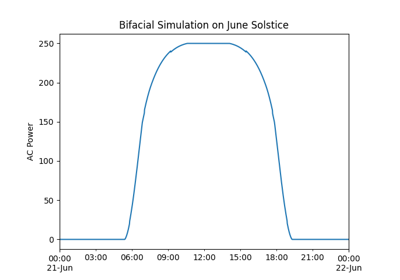pvlib.modelchain.ModelChain.run_model_from_effective_irradiance#
- ModelChain.run_model_from_effective_irradiance(data)[source]#
Run the model starting with effective irradiance in the plane of array.
Effective irradiance is irradiance in the plane-of-array after any adjustments for soiling, reflections and spectrum.
- Parameters
data (DataFrame, or list or tuple of DataFrame) –
Required column is
'effective_irradiance'. Optional columns include'cell_temperature','module_temperature'and'poa_global'.If the ModelChain’s PVSystem has multiple arrays, data must be a list or tuple with the same length and order as the PVsystem’s Arrays. Each element of data provides the irradiance and weather for the corresponding array.
- Returns
self
- Raises
ValueError – If the number of DataFrames in data is different than the number of Arrays in the PVSystem.
ValueError – If the DataFrames in data have different indexes.
Notes
Optional
datacolumns'cell_temperature','module_temperature'and'poa_global'are used for determining cell temperature.If optional column
'cell_temperature'is present, these values are used and temperature_model is ignored.If optional column
'module_temperature'is preset, temperature_model must be'sapm'.Otherwise, cell temperature is calculated using temperature_model.
The cell temperature models require plane-of-array irradiance as input. If optional column
'poa_global'is present, these data are used. If'poa_global'is not present,'effective_irradiance'is used.Assigns attributes to results:
times,weather,total_irrad,effective_irradiance,cell_temperature,dc,ac,losses,diode_params(if dc_model is a single diode model).
